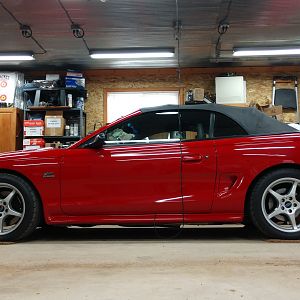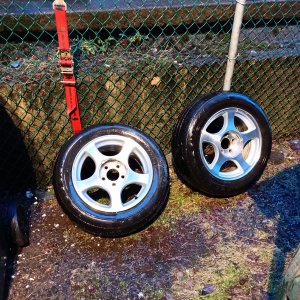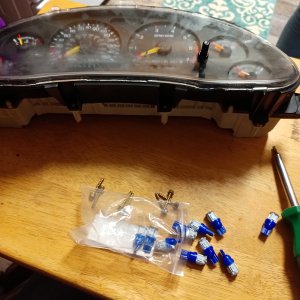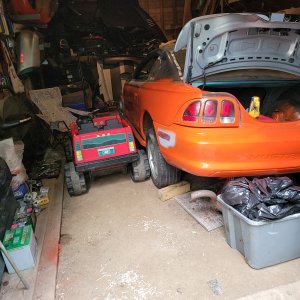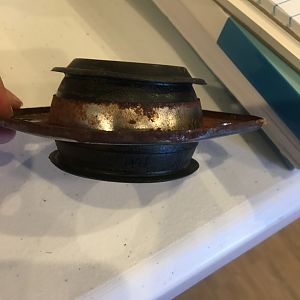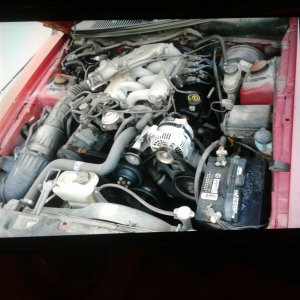amf201091
Member
I just want to start out by saying, I'm no "mechanic" by any means. I simply want to share a positive experience I had (thank god) on a test kit that I believe ANYONE can use and be able to diagnose if/where they are leaking coolant and if they have a failed head gasket or some other internal issue that is causing coolant to disappear. This test is relatively inexpensive and easy to do.
1) Go to any automotive store and pick up a Radiator Pressure Test Kit. These can vary in prices; I got mine for $89.00 at Harbor Freight.

2) These kits come with many different attachments and will look different depending on the kit you have. On this particular kit, my SN95 used the yellow adapter. You can refer to the instructions of the kit which will tell you which one will most likely fit your car.


3) With the car off and engine cold, you will remove the radiator cap and screw on the yellow radiator adapter.

4) Attach the air pump to the yellow radiator adapter.


5) Now you will want to make sure what PSI your radiator/cooling system is rated as this will be the amount you want to reach on the pressure gauge. I referred to my radiator cap (16 PSI). You can also find this rating in your service manual.

6) Now comes the workout! Use the hand pump and begin pumping air into the cooling system. Keep an eye on the air pump's pressure gauge. My pump is split into PSI and BAR but I just went off of the PSI reading. There should be a moderate amount of coolant in the system for this to work. The pressure gauge should start climbing after 10 pumps or so. This is also a good time to turn off any music that you have playing. Listen for any hissing sounds (kind of like a balloon that is slowly releasing air) which would indicate you have a leak. (DO NOT MAKE ANY REPAIRS OR ADJUSTMENTS WITHOUT RELEAVING ALL PRESSURE FIRST) (There should be a air relief valve on the pump itself or SLOWLY unscrew the radiator cap adapter to release pressure).

7) Once you hit your targeted PSI stop pumping. It's important you don't go to much over your specified PSI as this could cause damage to your cooling system. Now, let the car sit for 10 minutes or so and periodically check on the gauge. While you're waiting go ahead and inspect underneath the car and see if you can see any coolant leaking. Once 10 minutes has passed, inspect the gauge again and see if it has dropped pressure.
8) If the pressure has dropped, double check to see if the adapter is tightly screwed on and that the air pump isn't leaking air.
9) If pressure still continues to drop, inspect your cooling system carefully as there is more than likely a leak (radiator, hoses, thermostat housing, etc). If you don't see/hear an external leak then that could be a good indicator that you have a bad head gasket OR (if you have an automatic transmission) your transmission cooler is leaking coolant into your transmission. Both are pretty bad (and $$$) and should be repaired as quick as possible to avoid further damage.
10) If pressure remains steady then you're good to go!
*After making necessary repairs/adjustments, keep repeating these steps until your system maintains correct pressure.
If you think you have a bad head gasket, look into combining this test with a carbon dioxide vapor test. That test is also easy to perform and isn't pricey. You can usually rent the test kit from autozone.
Hope this helps!
1) Go to any automotive store and pick up a Radiator Pressure Test Kit. These can vary in prices; I got mine for $89.00 at Harbor Freight.

2) These kits come with many different attachments and will look different depending on the kit you have. On this particular kit, my SN95 used the yellow adapter. You can refer to the instructions of the kit which will tell you which one will most likely fit your car.


3) With the car off and engine cold, you will remove the radiator cap and screw on the yellow radiator adapter.

4) Attach the air pump to the yellow radiator adapter.


5) Now you will want to make sure what PSI your radiator/cooling system is rated as this will be the amount you want to reach on the pressure gauge. I referred to my radiator cap (16 PSI). You can also find this rating in your service manual.

6) Now comes the workout! Use the hand pump and begin pumping air into the cooling system. Keep an eye on the air pump's pressure gauge. My pump is split into PSI and BAR but I just went off of the PSI reading. There should be a moderate amount of coolant in the system for this to work. The pressure gauge should start climbing after 10 pumps or so. This is also a good time to turn off any music that you have playing. Listen for any hissing sounds (kind of like a balloon that is slowly releasing air) which would indicate you have a leak. (DO NOT MAKE ANY REPAIRS OR ADJUSTMENTS WITHOUT RELEAVING ALL PRESSURE FIRST) (There should be a air relief valve on the pump itself or SLOWLY unscrew the radiator cap adapter to release pressure).

7) Once you hit your targeted PSI stop pumping. It's important you don't go to much over your specified PSI as this could cause damage to your cooling system. Now, let the car sit for 10 minutes or so and periodically check on the gauge. While you're waiting go ahead and inspect underneath the car and see if you can see any coolant leaking. Once 10 minutes has passed, inspect the gauge again and see if it has dropped pressure.
8) If the pressure has dropped, double check to see if the adapter is tightly screwed on and that the air pump isn't leaking air.
9) If pressure still continues to drop, inspect your cooling system carefully as there is more than likely a leak (radiator, hoses, thermostat housing, etc). If you don't see/hear an external leak then that could be a good indicator that you have a bad head gasket OR (if you have an automatic transmission) your transmission cooler is leaking coolant into your transmission. Both are pretty bad (and $$$) and should be repaired as quick as possible to avoid further damage.
10) If pressure remains steady then you're good to go!
*After making necessary repairs/adjustments, keep repeating these steps until your system maintains correct pressure.
If you think you have a bad head gasket, look into combining this test with a carbon dioxide vapor test. That test is also easy to perform and isn't pricey. You can usually rent the test kit from autozone.
Hope this helps!
Attachments
Last edited:



